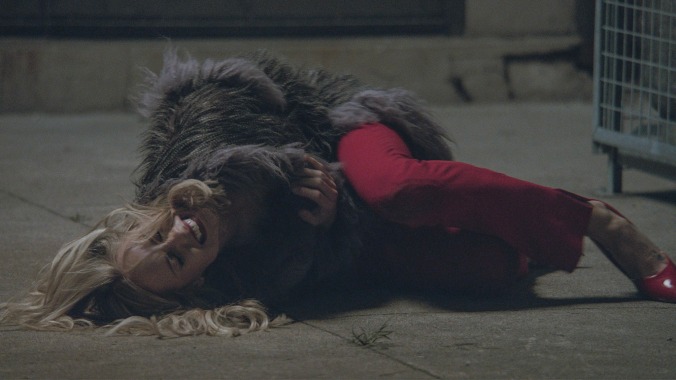What’s the point of a toothless Rabid remake?


Note: This review contains an image that some readers may find disturbing.
Of all the things to lose in a remake of David Cronenberg’s 1977 body-horror shocker Rabid, diluting the Canadianness of it all is a disappointing choice. Not to mention a confusing one: The film was shot in Toronto, and characters with Canadian accents pop up throughout the film. There’s even a Stephen McHattie cameo, just to underline that this is a Canadian production. However, a reworked plot point hinges on the high cost of healthcare—not a problem Canadians generally have to worry about—and the script makes several references to the Centers For Disease Control And Prevention, an American institution. These are quibbles, to be sure. But they’re also indicative of the project overall, which—although it has its moments—struggles to bring a coherent or original vision to the material.
The biggest change writer-directors Jen and Sylvia Soska make to Rabid is giving its protagonist a work life, rewriting Rose (Laura Vandervoort) as a meek seamstress working for clichéd German fashion designer Gunter (Mackenzie Gray). Rose dreams of starting her own fashion line, but suffers from a lack of confidence that presumably stems from the fact that she wears glasses. Her self-esteem is further shattered by a horrific motorcycle accident that leaves her with a nightmarish facial deformity, until plastic surgeon Dr. William Burroughs (Ted Atherton) offers to perform an experimental surgery on her free of charge. The stem cell graft Dr. Burroughs places on the gaping hole in Rose’s jaw looks like one of those clear plastic insoles you slip into a pair of uncomfortable heels, and leaves her with a fleshy tube that sticks out from her armpit like an anglerfish’s lure. Oh, yes, and an insatiable bloodlust that compels her to rip leering men into bloody ribbons.
Like their countryman Cronenberg, the Soskas specialize in body horror, and their 2012 film American Mary gets quite a bit of mileage out of extreme body modification and surgical gore. Here, whether due to budgetary constraints or a lack of vision, the effects are tamer—with the notable exception of the gnarly prosthetic pictured below (fair warning). Scenes that should be absolutely soaked in blood are instead sprayed with a tasteful mist of artery juice, and even an elaborate creature design unveiled toward the end of the film isn’t utilized to its fullest. It’s a missed opportunity to compensate for the film’s low budget with balls-to-the-wall gore. Not only that, but as Rabid goes on, the brief spark of inspiration in the film’s unsettling initial hospital scenes is snuffed out by the clunky screenplay and generic performances.
Vandervoort similarly misses her chance to push boundaries as crazed seductress Rose. The character is fully in control of her own life and decisions, another notable change from the original film. But next to the bloodthirsty derangement of Dora Madison in Bliss (2019) and the feral eroticism of Garance Marillier in Raw (2017), Vandervoort’s freakouts seem restrained. Side characters, including Rose’s best friend and roommate Chelsea (Hanneke Talbot) and overly pushy love interest Brad (Ben Hollingsworth), are all underdeveloped and underplayed. And while it makes sense for the men in a female-driven update on Rabid to be insufferable—we want to get a little bit of pleasure from watching Rose tear them apart, after all—the film’s attempts to satirize the male ego in film and in fashion fall flat. The movie’s insistence that the already gorgeous Rose is utterly transformed basically by taking off her glasses further undermines the credibility of the story, as do a series of dream sequences that confuse the stakes a little further every time they appear.
The Soskas clearly love Cronenberg, and pay tribute to him with visual references to Dead Ringers (1988) and Shivers (1975) at various points throughout Rabid. And like the Soskas, Cronenberg got his start in low-budget filmmaking, cheap lighting, cheesy music, and all. But what seems to have been lost in translation between the original film and its remake is the mad genius that allowed Cronenberg’s version of Rabid to transcend its budgetary limitations and earn its place as a horror classic. Horror remakes don’t have to be inferior rehashes, as films like Jim Mickle’s We Are What We Are (2013) and Luca Guadagnino’s Suspiria (2018) have demonstrated. But this Rabid nibbles where it should clamp down hard.